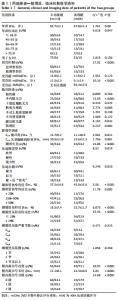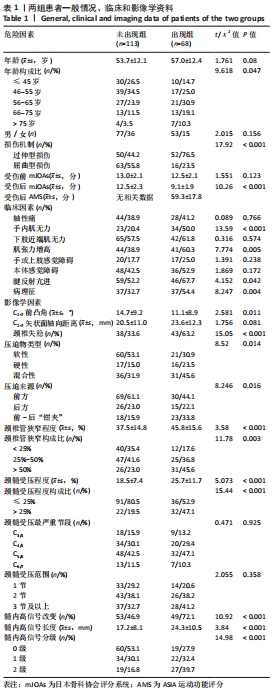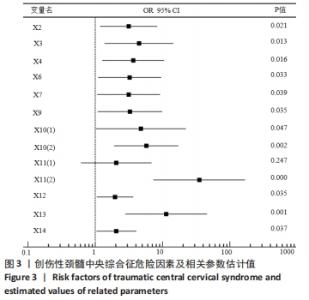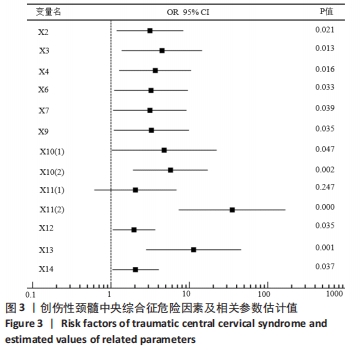Chinese Journal of Tissue Engineering Research ›› 2022, Vol. 26 ›› Issue (9): 1388-1394.doi: 10.12307/2022.434
Previous Articles Next Articles
Risk factors for traumatic central cord syndrome underlying with cervical spondylotic myelopathy
Wu Liang1, Wang Qiang2, Wang Wenbo1, Xin Tianwen1, Xi Kun1, Tang Jincheng1, Xu Jingzhi1, Chen Liang1, Gu Yong1
- 1Department of Orthopedics, First Affiliated Hospital of Soochow University, Suzhou 215006, Jiangsu Province, China; 2Suzhou Dushuhu Public Hospital, Suzhou 215000, Jiangsu Province, China
-
Received:2021-05-25Revised:2021-05-26Accepted:2021-07-16Online:2022-03-28Published:2021-12-10 -
Contact:Gu Yong, Associate chief physician, Department of Orthopedics, First Affiliated Hospital of Soochow University, Suzhou 215006, Jiangsu Province, China Chen Liang, Chief physician, Department of Orthopedics, First Affiliated Hospital of Soochow University, Suzhou 215006, Jiangsu Province, China -
About author:Wu Liang, Doctoral candidate, Department of Orthopedics, First Affiliated Hospital of Soochow University, Suzhou 215006, Jiangsu Province, China Wang Qiang, Master, Physician, Suzhou Dushuhu Public Hospital, Suzhou 215000, Jiangsu Province, China Wu Liang and Wang Qiang contributed equally to this article. -
Supported by:National Natural Science Foundation of China, No. 82072438 (to GY); No. 81972078 (to CL)
CLC Number:
Cite this article
Wu Liang, Wang Qiang, Wang Wenbo, Xin Tianwen, Xi Kun, Tang Jincheng, Xu Jingzhi, Chen Liang, Gu Yong. Risk factors for traumatic central cord syndrome underlying with cervical spondylotic myelopathy[J]. Chinese Journal of Tissue Engineering Research, 2022, 26(9): 1388-1394.
share this article
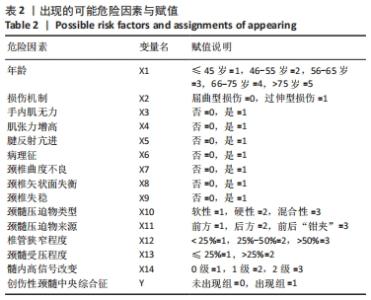
2.4 两组患者临床和影像学资料分析 两组患者临床和影像学资料分析 见表1。 受伤前, 两组患者轴性痛、下肢近端肌无力、手/上肢及本体感觉障碍阳性率比较差异均无显著性意义(P=0.766,0.574,0.238,0.172),出现组手内肌无力、下肢肌张力增高、腱反射亢进及病理征阳性率均高于未出现组(P < 0.001,P=0.005,P=0.042,P=0.004)。出现组患者C2-7 Cobb角小于未出现组(P=0.011),两组患者C2-7矢状面轴向距离比较差异无显著性意义(P=0.081)。出现组患者颈椎失稳率高于未出现组(P < 0.001)。 两组患者压迫物类型构成比较差异有显著性意义(P=0.014),出现组硬性和混合性占比多于未出现组;两组前方压迫物占比均最高,但未出现组“钳夹型”患者阳性率低于出现组(P=0.016)。两组患者均以C5/6受压最严重,其次为C4/5,两组间颈髓受压最严重节段分布比较差异无显著性意义(P=0.925)。两组颈髓受压范围比较差异无显著性意义(P=0.358)。出现组椎管最大狭窄程度大于未出现组(P < 0.001),椎管最大狭窄程度>50%比例高于未出现组(P=0.003)。出现组颈髓受压程度大于未出现组(P < 0.001);对于颈髓受压程度> 25%,出现组患者比例高于未出现组(P < 0.001)。出现组髓内高信号比例、长度及2级患者比例均高于未出现组(P 均< 0.001)。 2.5 Logistic逐步回归分析法筛选危险因素 年龄、椎管狭窄程度、颈髓受压程度及高信号改变是有序分类变量,而压迫物类型、来源为无序分类变量,其余均为二值变量。为便于进行逐步回归分析,对有序变量采用秩作得分,无序变量作哑变量,然后按连续变量处理并计算结果。Logistic回归分析结果显示Hosmer-Lemeshow检验P > 0.05(χ2=12.585,P=0.127),预测率89.0%,模型有统计学意义。进入方程的变量分别是损伤机制(X2)、手内肌无力(X3)、肌张力增高(X4)、病理征(X6)、颈椎曲度不良(X7)、颈椎失稳(X9)、压迫物类型[X10(1,2)]、压迫物来源[X11(2)]、椎管狭窄程度(X12)、颈髓受压程度(X13)及IHSI(X14),见表2,图3。"
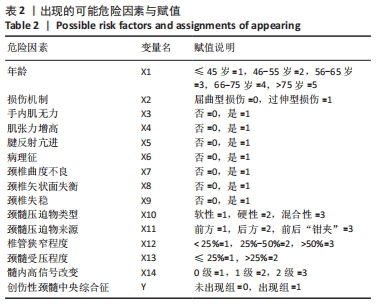
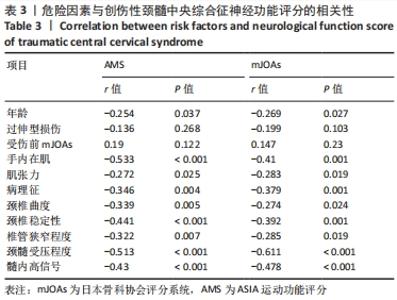
Logistic回归分析表明,创伤性颈髓中央综合征可能的危险因素为过伸型损伤、手内在肌无力、肌张力增高、病理征阳性、颈椎曲度不良、颈椎失稳、压迫物类型、来源、椎管狭窄程度、颈髓受压程度及髓内高信号,OR值分别为3.154,4.480,3.669,3.239,3.131,3.281,4.761(5.742),35.204,1.965,11.339及2.062(P < 0.05)。结果提示,当脊髓型颈椎病患者的致伤因素为过伸型损伤、或伴有相应临床体征(手内在肌无力、肌张力增高、病理征阳性)和影像学表现时(颈椎曲度不良、颈椎失稳、压迫物为硬性或混合性,压迫类型为前后“钳夹”型,椎管狭窄或颈髓受压程度较高,髓内高信号改变),将增加低能量损伤后致创伤性颈髓中央综合征的风险,其中前后“钳夹”型压迫和颈髓受压程度> 25%患者的风险相比参照组分别上升35.204,11.339倍。 2.6 危险因素与创伤性颈髓中央综合征神经症状严重度的相关性 未出现组受伤前mJOAs为(13.0±2.1)分,受伤后mJOAs为(12.5±2.3)分,受伤前后评分比较差异无显著性意义(P=0.089)。出现组mJOAs从受伤前的(12.5±2.1)分降至受伤后的(9.1±1.9)分(P < 0.001)。两组受伤前的mJOAs比较差异无显著性意义(P=0.123),受伤后的mJOAs比较差异有显著性意义(P < 0.001)。出现组受伤后ASIA评分C级24例,D级44例,AMS为(59.3±17.8)分。双变量相关性分析显示,年龄、手内肌无力、肌张力增高、病理征、颈椎曲度不良、颈椎失稳、椎管狭窄程度、颈髓受压程度及髓内高信号与受伤后AMS和mJOAs均呈显著负相关(P < 0.05),见表3。 "
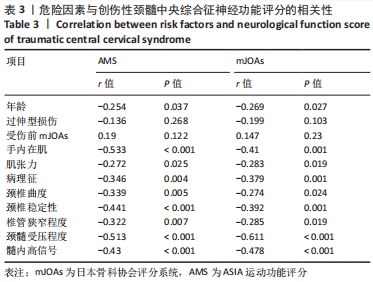
| [1] BOOGAARTS HD, BARTELS RH. Prevalence of cervical spondylotic myelopathy. Eur Spine J. 2015;24(2):139-141. [2] ALJUBOORI Z, BOAKYE M. The natural history of cervical spondylotic myelopathy and ossification of the posterior longitudinal ligament: a review article. Cureus. 2019;11(7):e5074. [3] 刘国臻,刘磊,王运涛.创伤性颈脊髓中央综合征的研究进展[J].中国脊柱脊髓杂志,2019,29(8):755-759. [4] BAKHSHESHIAN J, MEHTA VA, LIU JC. Current diagnosis and management of cervical spondylotic myelopathy. Global Spine J. 2017;7(6):572-586. [5] 杨海源,唐鹏宇,罗勇骏,等.颈脊髓中央管综合征手术治疗预后影响因素分析[J].中国骨与关节损伤杂志,2016,31(7):673-676. [6] 张辉,徐南伟,农鲁明,等.颈脊髓中央管综合征钛板内固定和药物治疗的预后因素分析[J].中国组织工程研究,2020,24(3):348-353. [7] GIANNOUDIS PV, MEHTA SS, TSIRIDIS E. Incidence and outcome of whiplash injury after multiple trauma. Spine (Phila Pa 1976). 2007;32(7):776-781. [8] DYSKIN E, HILL BW, TORCHIA MT, et al. A Survey of High- and Low-Energy Acetabular Fractures in Elderly Patients. Geriatr Orthop Surg Rehabil. 2019; 10:1-6. [9] 贾连顺.对过伸性颈脊髓损伤的再认识[J].中华外科杂志,2007,45(6): 363-365. [10] 龙浩,肖杰,郭涛,等.下颈椎屈曲分离型损伤的临床特点与手术选择[J].创伤外科杂志,2012,14(1):24-26. [11] 张黎龙,程招军,崔子健,等.MRI测量脊髓型颈椎病患者矢状位参数相关性分析[J].中国修复重建外科杂志,2017,31(4):451-454. [12] KONG C, LI XY, SUN XY, et al. The ratio of C2-C7 Cobb angle to T1 slope is an effective parameter for the selection of posterior surgical approach for patients with multisegmental cervical spondylotic myelopathy. J Orthop Sci. 2020;25(6):953-959. [13] 邓元,倪斌.颈椎矢状序列测量方法的研究进展[J].中国脊柱脊髓杂志, 2014,24(7):655-659. [14] JOUIBARI MF, LE HUEC JC, RANJBAR HAMEGHAVANDI MH, et al. Comparison of cervical sagittal parameters among patients with neck pain and healthy controls: a comparative cross-sectional study. Eur Spine J. 2019;28(10): 2319-2324. [15] LIN T, WANG Z, CHEN G, et al. Is Cervical Sagittal Balance Related to the Progression of Patients with Cervical Spondylotic Myelopathy? World Neurosurg. 2020;137:e52-e67. [16] FEHLINGS MG, FURLAN JC, MASSICOTTE EM, et al. Interobserver and intraobserver reliability of maximum canal compromise and spinal cord compression for evaluation of acute traumatic cervical spinal cord injury. Spine (Phila Pa 1976). 2006;31(15):1719-1725. [17] MIYANJI F, FURLAN JC, AARABI B, et al. Acute cervical traumatic spinal cord injury: MR imaging findings correlated with neurologic outcome-prospective study with 100 consecutive patients. Radiology. 2007;243(3):820-827. [18] 张鹏,申勇,张英泽,等.MRI信号强度比值判断脊髓型颈椎病预后的意义[J].中华骨科杂志,2011,31(8):825-828. [19] 李振宇,林宏生,李恒国.颈髓MRI T_2信号强度比在脊髓型颈椎病手术前后的应用价值[J].临床放射学杂志,2018,37(5):733-736. [20] 刘忠军.对脊髓型颈椎病手术入路与术式的思考[J].中国脊柱脊髓杂志, 2009,19(7):481-482. [21] 陈亮,杨惠林,杨同其,等.外伤性颈髓中央综合征的手术治疗[J].中华骨科杂志,2007,27(8):566-571. [22] 叶一,蒋国强,程黎明.颈中央脊髓损伤综合征手术时间点与疗效的相关性[J].中华创伤杂志,2014,30(4):320-323. [23] KARADIMAS SK, GATZOUNIS G, FEHLINGS MG. Pathobiology of cervical spondylotic myelopathy. Eur Spine J. 2015;24(2):132-138. [24] 杨海源,蔡卫华.颈椎过伸性损伤机制与病理改变的研究进展[J].脊柱外科杂志,2016,14(2):117-120. [25] WINKELSTEIN BA, NIGHTINGALE RW, RICHARDSON WJ, et al. The cervical facet capsule and its role in whiplash injury: a biomechanical investigation. Spine (Phila Pa 1976). 2000;25(10):1238-1246. [26] 宋沛松,韩伟,崔华中,等.动态MRI评估过伸性颈椎损伤发生过程中椎管内容、椎体及椎间盘相关变化的意义[J].中国临床康复,2004, 8(26):5561-5563. [27] YAMAZAKI T, YANAKA K, FUJITA K, et al. Traumatic central cord syndrome: analysis of factors affecting the outcome. Surg Neurol. 2005;63(2):95-99. [28] 王林峰,申勇,张英泽,等.脊髓型颈椎病动态脊髓受压变化与疾病严重程度及预后的关系[J].中华医学杂志,2009,89(41):2883-2887. [29] 竺得洲,高杰,李连华,等.急性创伤性中央颈髓综合征手术治疗的预后因素分析[J].中国脊柱脊髓杂志,2018,28(11):975-981. [30] PAQUET J, RIVERS CS, KURBAN D, et al. The impact of spine stability on cervical spinal cord injury with respect to demographics, management, and outcome: a prospective cohort from a national spinal cord injury registry. Spine J. 2018;18(1):88-98. [31] 顾勇,王强,辛天闻,等.颈椎后路椎管扩大成形置入微型钛板:矢状面参数变化与修复效果的关系[J].中国组织工程研究,2016,20(44): 6570-6576. [32] NOURI A, TETREAULT L, ZAMORANO JJ, et al. Role of magnetic resonance imaging in predicting surgical outcome in patients with cervical spondylotic myelopathy. Spine (Phila Pa 1976). 2015;40(3):171-178. [33] 李智斐,钟远鸣,张家立,等.动态MRI检测颈椎健康者、颈肩部不适者脊髓型颈椎病未确诊及确诊者的价值[J].中国组织工程研究与临床康复,2010,14(48):8998-9002. [34] FARHADI HF, KUKREJA S, MINNEMA A, et al. Impact of admission imaging findings on neurological outcomes in acute cervical traumatic spinal cord injury. J Neurotrauma. 2018;35(12):1398-1406. [35] VEDANTAM A, JONATHAN A, RAJSHEKHAR V. Association of magnetic resonance imaging signal changes and outcome prediction after surgery for cervical spondylotic myelopathy. J Neurosurg Spine. 2011;15(6):660-666. [36] FERNANDEZ DE ROTA JJ, MESCHIAN S, FERNANDEZ DE ROTA A, et al. Cervical spondylotic myelopathy due to chronic compression: the role of signal intensity changes in magnetic resonance images. J Neurosurg Spine. 2007;6(1):17-22. [37] AVADHANI A, RAJASEKARAN S, SHETTY AP. Comparison of prognostic value of different MRI classifications of signal intensity change in cervical spondylotic myelopathy. Spine J. 2010;10(6):475-485. [38] AARABI B, HADLEY MN, DHALL SS, et al. Management of acute traumatic central cord syndrome (ATCCS). Neurosurgery. 2013;72(2):195-204. |
| [1] | Yao Xiaoling, Peng Jiancheng, Xu Yuerong, Yang Zhidong, Zhang Shuncong. Variable-angle zero-notch anterior interbody fusion system in the treatment of cervical spondylotic myelopathy: 30-month follow-up [J]. Chinese Journal of Tissue Engineering Research, 2022, 26(9): 1377-1382. |
| [2] | He Shiping, Jia Dazhou, Li Xiaolei, Wang Qiang. Establishment of prediction model of blood transfusion after proximal femoral nail anti-rotation fixation of femoral intertrochanteric fracture in elderly adults [J]. Chinese Journal of Tissue Engineering Research, 2022, 26(6): 929-933. |
| [3] | Cao Sheng, Kong Lingwei, Xu Kun, Sun Zhijie. Evaluation value of cervical sagittal plane sequence parameters on pain, cervical function and clinical efficacy in patients with cervical spondylotic myelopathy [J]. Chinese Journal of Tissue Engineering Research, 2022, 26(3): 419-424. |
| [4] | Zhou Shicheng, Han Hongguang, Ji Fang, Xu Liying, Zhang Xiaohui, Sun Chang. Effect and histocompatibility of expended polytetrafluoroethylene in modified Blalock-Taussig shunt [J]. Chinese Journal of Tissue Engineering Research, 2022, 26(21): 3394-3400. |
| [5] | Liu Chen, Hu Chengzhe, Yin Xun, Yu Ziheng, Yang Jiandong. Risk factors of residual pain after percutaneous vertebral augmentation for osteoporotic thoracolumbar compression fractures [J]. Chinese Journal of Tissue Engineering Research, 2022, 26(18): 2900-2905. |
| [6] | Li Wenle, Wang Haosheng, Ning Lijun, Zhang Wenshi, Gao Sen, Sun Lijun, Hu Zhaohui. Analysis of the risk for bone cement leakage after percutaneous vertebroplasty in osteoporosis patients and model verification [J]. Chinese Journal of Tissue Engineering Research, 2022, 26(10): 1477-1482. |
| [7] | Zhang Yu, Tian Shaoqi, Zeng Guobo, Hu Chuan. Risk factors for myocardial infarction following primary total joint arthroplasty [J]. Chinese Journal of Tissue Engineering Research, 2021, 25(9): 1340-1345. |
| [8] | Huang Zexiao, Yang Mei, Lin Shiwei, He Heyu. Correlation between the level of serum n-3 polyunsaturated fatty acids and quadriceps weakness in the early stage after total knee arthroplasty [J]. Chinese Journal of Tissue Engineering Research, 2021, 25(9): 1375-1380. |
| [9] | Wang Haiying, Lü Bing, Li Hui, Wang Shunyi. Posterior lumbar interbody fusion for degenerative lumbar spondylolisthesis: prediction of functional prognosis of patients based on spinopelvic parameters [J]. Chinese Journal of Tissue Engineering Research, 2021, 25(9): 1393-1397. |
| [10] | Zhang Chao, Lü Xin. Heterotopic ossification after acetabular fracture fixation: risk factors, prevention and treatment progress [J]. Chinese Journal of Tissue Engineering Research, 2021, 25(9): 1434-1439. |
| [11] | Liu Zhengpeng, Wang Yahui, Zhang Yilong, Ming Ying, Sun Zhijie, Sun He. Application of 3D printed interbody fusion cage for cervical spondylosis of spinal cord type: half-year follow-up of recovery of cervical curvature and intervertebral height [J]. Chinese Journal of Tissue Engineering Research, 2021, 25(6): 849-853. |
| [12] | Luo Xuanxiang, Jing Li, Pan Bin, Feng Hu. Effect of mecobalamine combined with mouse nerve growth factor on nerve function recovery after cervical spondylotic myelopathy surgery [J]. Chinese Journal of Tissue Engineering Research, 2021, 25(5): 719-722. |
| [13] | Chen Chaofeng, He Dadong, Liang Jincheng, He Zhijun. Predicting the possibility of blood transfusion after total knee arthroplasty based on machine learning algorithm [J]. Chinese Journal of Tissue Engineering Research, 2021, 25(36): 5792-5797. |
| [14] | Cai Xuan, Qin Jie, He Xijing, Dong Jun, Zhang Ting, Yang Wenlong, Wang Xiongxun, Wang Zili, Wang Dong, Li Haopeng, He Gaole, Lu Teng, Li Lingjiang. Three-dimensional printing motion-preserving cervical joint system implantation for treatment of cervical myelopathy: the first case report [J]. Chinese Journal of Tissue Engineering Research, 2021, 25(36): 5810-5813. |
| [15] | Li Long, Zhang Chunlin, Shao Chenglong, Yan Xu, Wang Yongkui, Liu Xiaokang, Li Dongzhe. Evaluation of natural resorption of herniated cervical intervertebral disc with different degrees of degeneration after cervical microendoscopic laminoplasty by three-dimensional volume method [J]. Chinese Journal of Tissue Engineering Research, 2021, 25(36): 5832-5837. |
| Viewed | ||||||||||||||||||||||||||||||||||||||||||||||||||
|
Full text 309
|
|
|||||||||||||||||||||||||||||||||||||||||||||||||
|
Abstract 640
|
|
|||||||||||||||||||||||||||||||||||||||||||||||||


